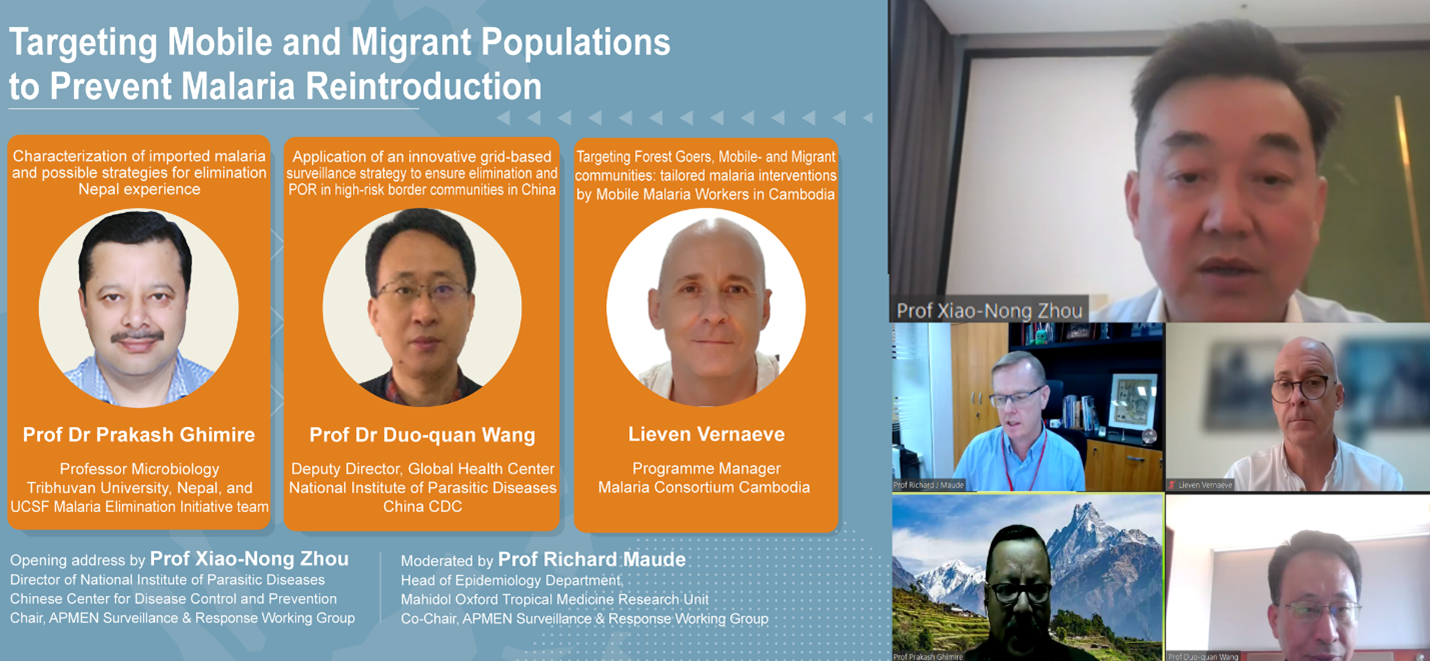
As efforts to eliminate malaria intensify, the adaptation of surveillance and response systems becomes crucial, driven by shifting epidemiology and the imperative to address remaining reservoirs of infection. Among these efforts, identifying and addressing the needs of high-risk populations, such as mobile and migrant populations (MMPs), emerges as a critical priority. These groups play a significant role in sustaining transmission and present challenges for prevention of malaria reintroduction.
Recently, the APMEN Surveillance and Response Working Group (SRWG) organized a TechTalks webinar titled “Targeting Mobile and Migrant Populations to Prevent Malaria Reintroduction” to explore experiences and strategies from across the region. The webinar, opened by Prof. Xiao-Nong Zhou from Chinese Center for Disease Control and Prevention, and moderated by Prof. Richard J Maude from Mahidol-Oxford Tropical Medicine Research Unit, delved into the challenges and successes of adapting surveillance strategies to effectively track MMPs, particularly in geographically clustered areas where malaria foci persist.
Prof. Prakash Ghimire, from Tribhuvan University in Nepal, explored strategies for addressing imported malaria and achieving elimination within Nepal. Despite an impressive 98% reduction in indigenous cases over the past decade, Nepal has witnessed a surge in imported cases, particularly among males, with P. vivax as the predominant parasite. Through a prospective analysis involving interviews and focus group discussions, Prof. Ghimire uncovered seasonal travel patterns of MMPs returning from India. Many of these individuals lack awareness of free malaria services at public facilities, leading them to seek treatment in the private sector. While some MMPs are willing to share referrals, logistical challenges impede effective follow-up. Border screening, given the high volume of cross-border movement, raises concerns about cost-effectiveness, particularly with low positivity rates. Furthermore, unofficial border crossings lack screening, exacerbated by privacy concerns, distrust of border security, and inconvenience. A pilot program in 2022-23 integrating HIV, TB, and malaria screening highlighted deficiencies in transit services and underscored the importance of local ownership by municipalities for program sustainability. Prof. Ghimire stressed the need to enhance awareness of available malaria services, improve health infrastructure at borders, time interventions effectively, ensure accessible malaria screening, and leverage migrant Labor camps and community centres in India for preventive awareness, emphasizing collaboration with India for successful implementation.
Prof. Duoquan Wang, representing the National Institute of Parasitic Diseases, China CDC, presented on the application of a grid-based surveillance strategy to prevent malaria reintroduction in high-risk border communities in China. Despite China's malaria-free certification in 2021, the threat of imported cases persists, especially in Yunnan province, bordering Myanmar, Laos, and Vietnam. Daily border crossings by MMPs contribute significantly to the challenge, with about 30% of China's yearly imported cases being identified in Yunnan. The grid-based strategy, established since the SARS crisis in 2003, operates at a grassroots level, covering small areas of approximately 10km², ensuring early detection and timely treatment and response of MMPs. Prof. Wang highlighted collaboration across various levels, from village committees to township hospitals and local CDCs, for MMP tracking and registration under a vertical structure, while timely testing and treatment are provided through a horizontal structure. Quantitative analysis revealed a substantial increase in the screening rate, indicating the strategy's effectiveness. Prof. Wang concluded by emphasizing the vital role of grid-based management in community malaria case management in Yunnan's border areas, aiding in reaching high-risk populations and consolidating malaria elimination efforts in the region.
Lieven Vernaeve, from Malaria Consortium in Cambodia, presented a practical approach to tailor malaria interventions using Mobile Malaria Workers (MMWs) targeting forest-goers and MMP communities in northern Cambodia. MMWs, recruited locally and trusted by communities, offer a range of free services, focusing particularly on high-risk groups such as MMPs in remote areas. Operating at entry points to forests and mountainous areas, MMWs provide round-the-clock services, including fever screening and health promotion. Data analysis showcased their significant contribution to testing and case management among MMPs in 6 provinces. Challenges identified included role transitions, vertical service provision, and funding shortages. Proposed solutions included diversifying MMWs' duties, exploring cost recovery, and integrating their roles with other community health workers. Lieven stressed the importance of flexible, community-driven approaches and collaboration with local authorities and health services for sustainable malaria elimination.
The webinar, attended by over 170 participants from 33 countries, underscored the critical role of surveillance and response strategies in malaria elimination efforts for at-risk populations. To watch the full recording of the TechTalks webinar, click here. In the global fight against malaria, targeting mobile and migrant populations remains a pivotal strategy, ensuring that no community is left behind in the journey towards regional elimination.
